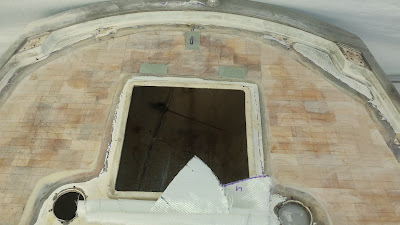The warm weather has continued here in the eastern part of the United States, which has enabled me to continue my boat work. I am really trying to get this side deck closed up before Mother Nature decides to bring winter in full force. I worked over the last few weeks preparing the exposed area of the port side deck.
I picked up where I left off and cut the new Core-cell core. This stuff is super easy to work with. I laid all the core in place and marked it for the G10 board.
All the G10 board cut and ready, and in its final resting spot sandwiched between the inner and outer deck. I also beveled the edges of the old skin to provide a nicely prepped surface for the new fiberglass to grab onto to make a good strong joint and bond.
First mate and I had a few days off over Christmas. Outside temperatures soared close to 80! We took advantage and decided to lay in the new core.
To prep the area for new core and G10 board we cleaned the entire area twice with acetone. Once cleaned we mixed straight West System resin with the 206 West Systems slow hardener. This mixture would give us ample working time with the warm temperatures. After we wetted out the entire area with the resin mixture we let it sit for about 10-15 minutes. During this time we starting mixing the West Systems resin with 206 and 406 Adhesive Filler. As with the lazarette area, we used this mixture to spread under the new core, bedding it into the existing deck.
Here is a piece of the new core all wet with epoxy waiting to be laid down.
After we had a all the core in and all voids filled with the thickened epoxy we applied the sandbags to weight it all down. This prevents the core from lifting and makes sure it stays conformed to the deck's contour.
The next morning, thanks to another day off, I got right to work sanding the cured epoxy and new core in preparation for new top layers of fiberglass. I did not get any pictures of the finished core but it took a good hour to prep it. After it was all prepped I began laying out and cutting the fiberglass.
I marked all the fiberglass pieces with a sharpie markers to help with the placement.
The second layer all cut and marked.
Close up of the new fiberglass laid over the previously damaged stanchion area (see previous posts for before pics of the damage).
A little trimming and tweaking was needed.
After wetting out the area completely I laid on the first two pieces of new side-deck top skin fiberglass.
All wet out with West Systems epoxy, showing the G10 and core.
Much better than what was there before and I would venture to say even better than new!
First layer with all air bubbles removed ready for next layer. You can see the G10 board I laid into the core for the jib track. This will provide strength and prevent water from leaking into the core.
The entire area with 2 layers of new 1708 biaxial fiberglass applied. I made sure to stagger the seams between layers.
After letting the area set up for about 30 minutes, I applied a skim coat of the 407 fairing epoxy to help fill in the weave of the fiberglass. I thought this area of the deck was only going to need 2 layers to complete the new top skin. After a bit of sanding I now realize another layer of fiberglass will be needed. I am not sure I will get the additional layer on this winter but at least the area is all sealed up and can be walked on (we excitedly tested that out just this afternoon and were pleased with the results!)
Stay tuned! A surprise is in the works...



















































